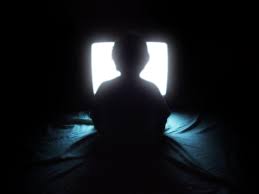No one thinks they are taking away a basketball or bicycle when they give an adolescent a phone. But there is an implicit swap at work.
The College of New Jersey’s Sarnoff Collection includes a 1948 RCA television, its small round screen surrounded by a hulking box of wood and clunky Bakelite knobs. The black and white television still works, these days using its limited lines of pixels to show You Bet Your Life to visitors who walk by.
 It’s a stark reminder that it’s glow even then was showing us our future. Television was one of the the earliest forms of screen-based technology. It would soon alter the psychology and even physiology of most of us living in the Western World.
It’s a stark reminder that it’s glow even then was showing us our future. Television was one of the the earliest forms of screen-based technology. It would soon alter the psychology and even physiology of most of us living in the Western World.
I’m speaking less of television itself, than its constituent elements that made it possible to deliver sound and pictures in a box. Now, of course, the technology has evolved and exists in many platforms: everything from phones to virtually every desktop. The ubiquitous presence of screens in our lives has come to dominate us in ways that ‘Bet Your Life’ host Groucho Marx could have never imagined.
What seems so noticeable is the screen’s effect to freeze children in place, a kind of physical demobilization from an earlier time when older children were the most ubiquitous travelers around our neighborhoods.
Most adults find reasons to sentimentalize their childhoods. It’s a generational perk. But even with those caveats, it remains true that the roaming habits of earlier generations provides a sharp point of contrast; in the twenty first century our stay-inside-kids venture less frequently beyond the front doors of their own homes.

Growing up in Denver, I was one of those “free range kids” that boomers revere. My territory was a big part of the eastern section of the city on the wheels of a modest three-speed bike. There was an expectation that I would wander home when I was hungry. And I was careful to stay off the city’s busiest streets. But for an adolescent a bike was its own form of freedom machine .
Favorite east side haunts included City Park, the city Zoo (free), the fences along the city’s airport runways, the Fox Theater in Aurora, and a wonderful natural history museum (free). Situated in the middle of City Park, what is now the Denver Museum of Nature and Science has a towering glass foyer that still features a panoramic view of the city center.
Once a drunk near the museum tried to steal my bike. I said “no” and he left. It would have been a long walk home without it. Besides, stories of child abductions didn’t haunt the airwaves, leaving most parents comfortable with the basic decency of the city’s population.
A recent study in Seattle found that children between the ages of 10 to 16 now use only 12.6 minutes per day for vigorous outdoor activity, compared with over 10 waking hours of motionless staring at screens. That’s a staggering imbalance. Research from Britain’s National Trust suggests a similar result, with kids in the U.K. spending half the time of what their parents as children spent outdoors. As a result, these days teens tend to be a bit thicker and slower.
Of course many kids in tough neighborhoods are deprived of their birthright to explore their surroundings. Since nearly one in five of American children live below the poverty line, we are talking about a lot of children. It’s also true that prior generations of Americans weren’t necessarily spending unscheduled time in verdant city parks. As a child, my father in law was sent out on winter days to pick up coal along the railroad tracks. In northern Michigan this was in no sense “recreational;” the family was desperate for the fuel to stave off the cold.
Our lives have given way to mediated experience instead of richer forms of lived experience.
Even so, many families today have sufficient means to live in a cocoon of non-stop digital entertainment. Computers, phones and electronic games are on more than they are off. These platforms provide a kind of electronic wallpaper that can have the effect of putting kids under voluntarily house arrest: victims of a kind of what I call ‘screen thrall.’ One effect of their constant digital contact is to even make a tame backyard can look potentially threatening. Our lives have given way to mediated experience instead of richer forms of lived experience.
And so we are on the period of widely reported police interrogations of any parents who let their adolescent children walk to school unescorted. In my neighborhood on most mornings I see kids escorted to the street from their house in the family’s massive SUV. It ferries them from the front door to the street, where parent and charge sit and wait for the arrival of a bus.
If this sounds like we have made ourselves prisoners to our digital technologies, it’s more of plea for a sense of balance. A screen demands a sedentary viewer. No one thinks they are taking away a basketball, jump rope or bicycle when they give an adolescent a phone or tablet. But there is an implicit swap. We only need to look around at empty yards in most neighborhoods to know where the kids have gone.
![]()


